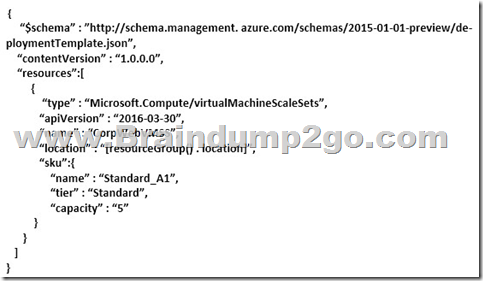[Dec-2017-New]100% Real Exam Questions-Braindump2go 70-532 PDF Dumps 254Q Download[Q212-Q227]
2017 Dec New Microsoft 70-532 Exam Dump with PDF and VCE Free Updated Today! Following are some new added 70-532 Exam Questions:
1.2017 New 70-532 Exam Dumps (PDF and VCE) 254Q&As Share:
https://www.braindump2go.com/70-532.html
2.2017 New 70-532 Exam Questions & Answers:
https://drive.google.com/drive/folders/0B75b5xYLjSSNS2ZGZHlZQWdyU3M?usp=sharing
QUESTION 212
Note: This question is part of a series of questions that present the same scenario. Each question in the series contains a unique solution that might meet the stated goals. Some question sets might have more than one correct solution, while others might not have a correct solution.
After you answer a question in this sections, you will NOT be able to return to it. As a result, these questions will not appear in the review screen.
You have a web app that is deployed to Azure.
You need to download a compressed collection of the diagnostic logs.
What should you use?
A. Azure PowerShell
B. File Transfer Protocol (FTP)
C. Application Insights
D. Microsoft Visual Studio
Answer: A
Explanation:
Diagnostic information stored to the web app file system can be accessed directly using FTP. It can also be downloaded as a Zip archive using Azure PowerShell or the Azure Command-Line Interface.
References: https://docs.microsoft.com/en-us/azure/app-service/web-sites-enable-diagnostic-log#download
QUESTION 213
Note: This question is part of a series of questions that present the same scenario. Each question in the series contains a unique solution that might meet the stated goals. Some question sets might have more than one correct solution, while others might not have a correct solution.
After you answer a question in this sections, you will NOT be able to return to it. As a result, these questions will not appear in the review screen.
You are developing a new Azure Logic App.
The Logic App requires a custom action to evaluate data from an internal, proprietary system.
You create a custom ASP>NET Web API to retrieve data from the system and update the Logic App to use the API.
The Logic App generates a timeout error when it requests data from the API.
You need to eliminate the timeout error and allow the Logic App to retrieve data by using the API.
What should you do?
A. Update the API to immediately return an HTTP `102 PROCESSING’ response when a request is received and an HTTP `205 RESET CONTENT’ response when the data is returned from the system.
B. Update the Logic App to use a new HTTPWebhook trigger to call out to the API’s newly- created subscribe and unsubscribe methods.
C. Update the API to immediately return an HTTP `202 ACCEPTED’ response when a request is received and an `200 OK’ response when the data is returned from the system.
D. Update the Logic App adding a wait action to include the interval object’s unit and count properties set to valid values.
Answer: C
QUESTION 214
Hotspot Question
You plan to migrate an Azure Web App named Contoso from an App Service plan named AppServicePlan1 to another App Service plan.
You create a resource group named ContosoGroup.
You create the following Azure PowerShell script. Line numbers are included for reference only.

For each of the following statements, select Yes if the statement is true. Otherwise, select No.
NOTE: Each correct selection is worth one point.

Answer:

QUESTION 215
Note: This question is part of a series of questions that present the same scenario. Each question in the series contains a unique solution that might meet the stated goals. Some question sets might have more than one correct solution, while others might not have a correct solution.
After you answer a question in this section, you will NOT be able to return to it. As a result, these questions will not appear in the review screen.
You deploy a Virtual Machine Scale Set (VMSS) named CorpWebVMSS to Azure by using Azure PowerShell and set the instance count to 1. The VMSS includes a storage account, load balancer, public IP address. and six Standard_A1 Windows virtual machines (VMs) that run Internet Information Services (IIS). All components are deployed to a resource group named CorpWebRG.
You must increase the instance count to support the increased load on IIS.
You need to manually scale out the number of VMs in the scale set to 5.
Solution: You run the following Azure PowerShell commands:
$vmss = Get-AzureRmVmss -ResourceGroupName CorpWebRG 璙MScalesSetName CorpWebVMSS
$vmss.Sku.Capacity = 5
Update-AzureRmVmss -ResourceGroupName CorpWebRG -Name CorpWebVMSS – VirtualMachineScaleSet $vmss
Does the solution meet the goal?
A. Yes
B. No
Answer: B
QUESTION 216
Drag and Drop Question
You need to add code at line CC63 to ensure that the Interaction Agent is invoked.
How should you complete the code? To answer, drag the appropriate code segments to the correct locations. Each code segment may be used once, more than once, or not at all. You may need to drag the split bar between panes or scroll to view content.
NOTE: Each correct selection is worth point.

Answer:

QUESTION 219
You are developing an Azure-hosted application that processes request messages for multiple office locations. You create an Azure Service Bus topic named Requests. The topic has a maximum size of 5 gigabytes (GB) and a default message time to live (TTL) of 5 minutes.
You also create subscriptions named PriorityRequest and StandardRequest and include appropriate logic to route the messages.
Users report that the application has not processed messages from PriorityRequest in several days.
You need to retrieve the number of messages in the PriorityRequest subscription.
Which metric Should you use?
A. Subscription Length
B. Subscription Incoming Requests
C. Topic Incoming Messages
D. Topic Size
Answer: D
QUESTION 222
Note: This question is part of a series of questions that present the same scenario. Each question in the series contains a unique solution that might meet the stated goals. Some question sets might have more than one correct solution, while others might not have a correct solution.
After you answer a question in this section, you will NOT be able to return to it. As a result, these questions will not appear in the review screen.
You deploy a Virtual Machine Scale Set (VMSS) named CorpWebVMSS to Azure by using Azure PowerShell and set the instance count to 1. The VMSS includes a storage account, load balancer, public IP address. and six Standard_A1 Windows virtual machines (VMs) that run Internet Information Services (IIS). All components are deployed to a resource group named CorpWebRG.
You must increase the instance count to support the increased load on IIS.
You need to manually scale out the number of VMs in the scale set to 5.
Solution: You run the following command by using the Azure Command-Line Interface (CLI):
azure vmss scale -g CorpWebRG -n CorpWebVMSS -c 5
Does the solution meet the goal?

A. Yes
B. No
Answer: A
QUESTION 223
Note: This question is part of a series of questions that present the same scenario. Each question in the series contains a unique solution that might meet the stated goals. Some question sets might have more than one correct solution, while others might not have a correct solution.
After you answer a question in this section, you will NOT be able to return to it. As a result, these questions will not appear in the review screen.
You deploy a Virtual Machine Scale Set (VMSS) named CorpWebVMSS to Azure by using Azure PowerShell and set the instance count to 1. The VMSS includes a storage account, load balancer, public IP address. and six Standard_A1 Windows virtual machines (VMs) that run Internet Information Services (IIS). All components are deployed to a resource group named CorpWebRG.
You must increase the instance count to support the increased load on IIS.
You need to manually scale out the number of VMs in the scale set to 5.
Solution: You deploy the following JSON template by using Azure PowerShell:
Does the solution meet the goal?
A. Yes
B. No
Answer: A
Explanation:
https://docs.microsoft.com/en-us/azure/virtual-machine-scale-sets/virtual-machine-scale-sets-autoscale-overview
QUESTION 224
You manage an on-premises server that runs Windows Server 2016. The server has a disk that contains 4 terabytes (TB) of data and thousands of files. None of the individual files are larger than 1 TB. You plan to create a virtual machine (VM) in Azure to process the workload currently handled by the on-premises server.
You need to create a storage location for the data.
What should you do?
A. Create premium storage account. Use a D-series VM.
B. Configure a StorSimple virtual array. Configure the VM to use the array with the SMB protocol.
C. Add a new table storage account. Update the VM workload to use the table storage.
D. Add a single le share to the VM. In the VM operating system, assign a drive letter.
Answer: D
QUESTION 226
Note: This question is part of a series of questions that present the same scenario. Each question in the series contains a unique solution that might meet the stated goals. Some question sets might have more than one correct solution, while others might not have a correct solution.
After you answer a question in this sections, you will NOT be able to return to it. As a result, these questions will not appear in the review screen.
You develop an enterprise application that will be used only by the employees of a company. The application is not Internet-facing. You deploy instances of the application to Azure datacenters on two continents.
You must implement a load balancing solution that meets the following requirements:
– Provide network-level distribution of traffic across all instances of the application.
– Support HTTP and HTTPS protocols.
– Manage all inbound and outbound connections.
Any back-end virtual machine (VM) must be able to service requests from the same user or client session.
Solution: You implement Traffic Manager.
Does the solution meet the goal?
A. Yes
B. No
Answer: B
Explanation:
A Traffic Manager works at the DNS level. It uses DNS responses to direct end-user traffic to globally distributed endpoints. Clients then connect to those endpoints directly.
An application manager, which works at the Application level (Layer 7), is also required.
References: https://docs.microsoft.com/en-us/azure/application-gateway/application-gateway-introduction
QUESTION 227
Note: This question is part of a series of questions that present the same scenario. Each question in the series contains a unique solution that might meet the stated goals. Some question sets might have more than one correct solution, while others might not have a correct solution.
After you answer a question in this sections, you will NOT be able to return to it. As a result, these questions will not appear in the review screen.
You develop an enterprise application that will be used only by the employees of a company. The application is not Internet-facing. You deploy instances of the application to Azure datacenters on two continents.
You must implement a load balancing solution that meets the following requirements:
– Provide network-level distribution of traffic across all instances of the application.
– Support HTTP and HTTPS protocols.
– Manage all inbound and outbound connections.
Any back-end virtual machine (VM) must be able to service requests from the same user or client session.
Solution: You implement Traffic Manager and Application Gateway.
Does the solution meet the goal?
A. Yes
B. No
Answer: A
Explanation:
Application Gateway works at the application layer (Layer 7 in the OSI network reference stack). It acts as a reverse-proxy service, terminating the client connection and forwarding requests to back-end endpoints. It supports the HTTP, HTTPS, and WebSockets protocols. Application Gateway is useful for applications that require requests from the same user/client session to reach the same back-end virtual machine. Examples of these applications would be shopping cart applications and web mail servers.
Traffic Manager works at the DNS level. It uses DNS responses to direct end-user traffic to globally distributed endpoints. Clients then connect to those endpoints directly. Microsoft Azure Traffic Manager allows you to control the distribution of user traffic for service endpoints in different datacenters
References: https://docs.microsoft.com/en-us/azure/traffic-manager/traffic-manager-overview
!!!RECOMMEND!!!
1.2017 New 70-532 Exam Dumps (PDF and VCE) 254Q&As Share:
https://www.braindump2go.com/70-532.html
2.2017 New 70-532 Study Guide Video:
https://youtu.be/AAd9jylLxCc